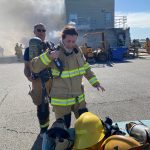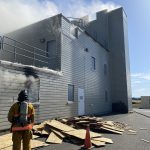 Fire Training Props Fuel Unique Experiences for Yuba College Cadets
Fire Training Props Fuel Unique Experiences for Yuba College Cadets
Yuba College Fire Academy
When it comes to training for California’s most intense forest fires, access to the proper equipment and technology is essential. It’s not like you can just burn down a house for practice.
Well, not anymore.
“When I came into the fire service, we used to get houses donated, since people just wanted the property, and we used to burn them for training,” reflects Chief Robert Stoddard, facilitator for the dynamic Yuba College Fire Technology program. “That was how I got most of my training as a firefighter — but that day is long gone.”
These days, it’s a little more complicated than lighting up an abandoned building. Yuba College’s Fire Tech program is helping blaze the trail for the next generation of cadets by providing access to high-tech fire training equipment. Thanks to these specially designed “props,” cadets are preparing to effectively fight the pervasive fires that burn through thousands of acres of wildlands in California every year.
“Props basically keep us at the front of the game,” says Stoddard. “You got to have the right props to give the best simulations you can.”
Supported by Strong Workforce Program (SWP) funds, the department’s most useful props include the “Phase 1,” a flashover chamber that provides students with vital fire behavior training. Flashover training helps cadets witness the entire process of combustion — from the beginning of ignition up to the fire’s dangerous flashover point.
Another impressive resource is the vent prop, which provides future firefighters with the realistic experience of breaking into a structure via a rooftop during a fire rescue. The prop can be adjusted to various angles and heights to help immerse cadets in the real-world scenario.
“Just like a roof, we can put it at different angles, we can go flat, we can do various things with saw work,” notes the Chief.
“It’s enhanced the quality of the education,” adds Mark Covington, Director of Public Safety at Yuba College.
These customizable props support cadets as they learn essential skills across the board, from basic firefighting knowledge like cutting and sawing in full turnout gear, to more advanced techniques like breaking into structures and prying open car doors. Especially valuable, according to Stoddard, was the ability to practice scenarios multiple times over. With repetition, the Chief says, cadets’ actions become automatic in the field: “Fire service is a lot of muscle memory, so the more repetitions you do, the better you’re going to do.”
Beginning at Yuba College in 1992 as an Emergency Medical Technician (EMT) instructor, Chief Stoddard brought a wealth of experience when the Fire Technology program began in 1997. He joined the team as a part-time Fire Tech instructor, while simultaneously working as a firefighter for the Yuba City Fire Department.
Now, Stoddard oversees the Fire Technology program at Yuba College. With an impressive 35-year career in the fire service, the retired Battalion Chief knows the skills and experiences – not to mention the equipment – cadets need to succeed in the challenging field.
“We’ve got 18 saws, four circular saws, we have a vehicle extrication prop, where we actually use the extrication tools,” lists Stoddard. “With these props, not that people can’t get hurt — they can … but it’s very controlled and we can give them a pretty realistic view and feel of what they might run into.
“It’s not going to be perfect, but we can get them pretty close.”
With the uptick in demand for firefighters throughout the region and state, the Fire Tech program is seeing substantial growth. The program runs about six Basic Wildland Academies every year, along with the Firefighter I EMT program in the spring. Recently, an additional Firefighter I Academy was added for students in the fall who already have their EMT or want to pursue the certification separately.
“In order to get a job, you’ve got to have your EMT,” continues the Chief. “What we found is there was a large number [of students] that just wanted to get their Firefighter I either because they already had EMT, or they prefer to take an EMT separately in another class.”
Alongside the essential medical experience, cadets in Yuba College’s program experience the full scope of life as a firefighter, thanks to industry-experienced instructors who have years of fire service under their belts. These cadets learn the fundamentals of firefighter life, including the hierarchy of a firehouse, dealing with stress, decision-making, and communication skills.
“Cadets attending the Yuba Community College Fire Academies benefit from longevity of the program, consistent facilitation with open door access, instructors strongly supported from the surrounding fire departments, and an amazing public administration staff,” says Fire Tech Instructor Michael Crandall. “These elements, combined, provide the cadet with a premier world class site to begin their professional firefighting career.”
In addition to SWP funds, donations from local fire departments are helping spark success in the program. Among the donated equipment are fire engines, which can run up price tags of millions of dollars. According to Stoddard, the valuable second-hand equipment usually sees five to 10 years of use for cadets in training.
“These programs are very expensive for the college just because of the staff hours, the equipment, and so forth,” explains the Chief. “If it wasn’t for Strong Workforce, we wouldn’t have a program, plain and simple.”
Even with financial restraints, the determined facilitator is always looking to improve the Fire Technology program. With technological advancements in tools like virtual reality, new industry-grade equipment, and scenario-based learning, Stoddard says, the possibilities are virtually endless.
 “I’m looking at different technology, such as simulators, with … virtual reality. There’s a lot of stuff out there now, which is not cheap … but it’s another avenue to get them even more training.”
“I’m looking at different technology, such as simulators, with … virtual reality. There’s a lot of stuff out there now, which is not cheap … but it’s another avenue to get them even more training.”
Plans are already in place to continue expanding the program’s training grounds and benefit the entire Public Safety department. Upgrades include additional training props and facilities that can be shared with the Yuba Law Enforcement Academy and EMT program.
“A lot of this equipment can be dual-purpose,” continues Stoddard. “I look at it as public safety. I don’t just look at it as fire technology.
“If we can get equipment and props that can be used for everybody, that just makes it all that much better.”
Sources:
https://www.fire.ca.gov/our-impact/statistics
https://www.onetonline.org/link/localtrends/33-2011.00?st=CA
May 2024